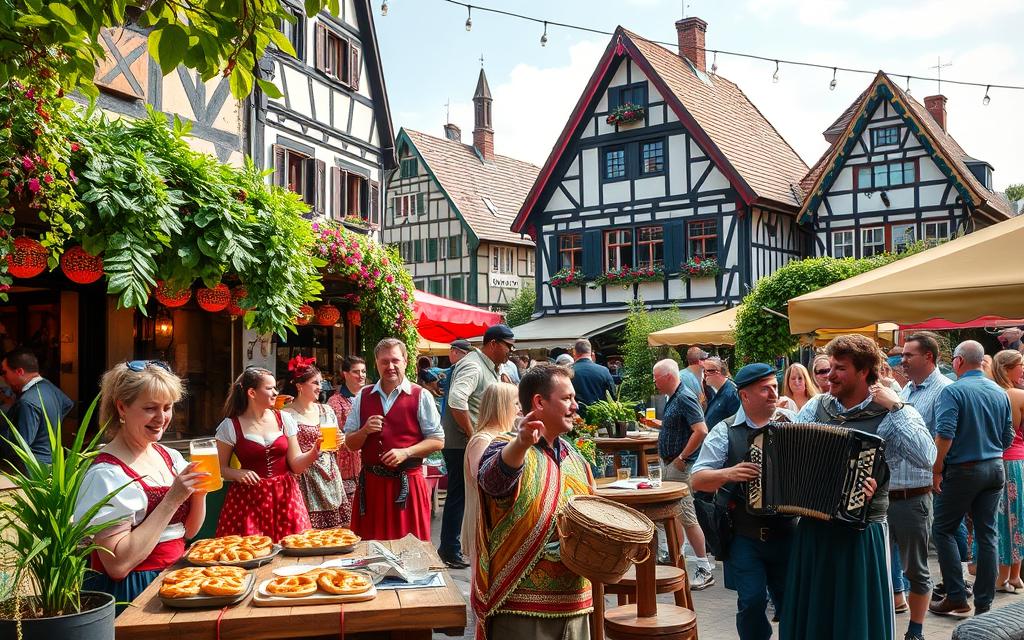Celebrating Arab American Heritage Month in the USA
April is a special time to celebrate Arab American history and culture. As an Arab American, I’m proud of our community’s role in the U.S. This month, we honor Arab Americans’ big impact from the 16th century to now.
Join me in learning about Arab American Heritage Month and its importance. We’ll look at Arab immigration waves and our community’s diversity. We’ll share stories of Arab Americans’ achievements in science, tech, art, and culture.
We’ll also talk about the challenges Arab Americans face with bigotry and stereotypes. Our goal is to build a deeper understanding and appreciation of our heritage.
By celebrating Arab American Heritage Month, we honor our past and work towards a future where Arab Americans are fully recognized. Let’s explore the rich history and culture of Arab Americans together.
What is Arab American Heritage Month?
Arab American Heritage Month is a celebration in April to honor Arab Americans. It started in 2017 by the Arab America Foundation. Now, it’s recognized by many states, counties, and schools across the U.S.
Origins and Significance
This month celebrates Arab American culture and history. It also fights against anti-Arab bias and stereotypes. It’s a chance to learn about and appreciate Arab American contributions to the country.
Presidential Recognition
In 2021, President Joe Biden made history by officially recognizing April as National Arab American Heritage Month. This move highlighted the importance of Arab American contributions and the need for inclusivity.
| Year | Significance |
|---|---|
| 2017 | Arab American Heritage Month launched by the Arab America Foundation |
| 2021 | President Joe Biden issues the first-ever presidential proclamation recognizing National Arab American Heritage Month |
arab american heritage month: A Rich History
The history of Arab Americans in the United States goes back centuries. The first Arab immigrants arrived in the 16th century. Estebanico Azemmouri from Morocco and Antonio Bishallany from Lebanon were among the first.
Early Arab Immigrants
In the 1800s, Arab Christians started coming to the U.S. They were fleeing from the Ottoman Empire because of religious persecution and economic troubles. This flow of immigrants lasted until the 1920s. Then, immigration laws changed, limiting how many people could come from certain countries.
Waves of Arab Immigration
Later, in the mid-20th century, more Arabs came to the U.S. This was due to political issues in the Middle East and North Africa. Also, changes in immigration laws in 1965 and the 1990s helped. These new immigrants brought many cultures, traditions, and experiences. They made the Arab American community diverse and rich.
Diversity Within the Arab American Community
The Arab American community is a rich mix of people from 22 countries in the Middle East and North Africa. They come from Algeria to Yemen, celebrating their national, religious, racial, and cultural backgrounds. Many Arab Americans follow Islam, Christianity, or other beliefs, showing the community’s complexity and vibrancy.
Arab Americans are not all the same in terms of race. They come from various ethnic backgrounds, with different skin tones, facial features, and physical traits. This diversity challenges the idea that all Arab Americans look or act the same.
| Nationality | Percentage of Arab American Population |
|---|---|
| Lebanese | 29% |
| Syrian | 18% |
| Egyptian | 14% |
| Palestinian | 12% |
| Jordanian | 7% |
| Other Arab Countries | 20% |
The Arab American community is also diverse in sexual orientation, gender identity, and abilities. This diversity adds to the richness of their heritage. The community’s diversity is a source of strength, resilience, and cultural vibrancy that should be celebrated.
Little Syria: Arab American Roots in New York City
New York City has been a key place for Arab American history and culture. In the late 1800s, Arab immigrants first came to the United States and settled in a neighborhood called “Little Syria.” This area, near Washington Street and Rector Street, was the heart of Arab life in the U.S. from the 1870s to the 1940s.
The Rise and Fall of Little Syria
By 1900, about 2,000 Syrians lived in Little Syria. They worked in textile factories and as merchants nearby. The area was also famous for Arab writers like Kahlil Gibran. He started the Pen Bond and helped create a strong Arab American literary scene.
But, the Brooklyn Battery Tunnel and the World Trade Center construction in the 1940s and 1960s led to the area’s decline. This caused the Little Syria community to move away.
Arab American Population in New York Today
Even though Little Syria is gone, New York City is still a key place for arab americans in new york. It has the second-most arab american history new york in the U.S. The arab americans in new york community is growing fast.

Recommended Reading for Arab American Heritage Month
During Arab American Heritage Month, families, educators, and students can dive into the rich history and culture of the Arab diaspora through literature. This list includes fiction and non-fiction for all ages, from early readers to high schoolers.
Early Readers
- “The Arabic Quilt: An Immigrant Story” by Aya Khalil
- “Lailah’s Lunchbox: A Ramadan Story” by Reem Faruqi
- “Counting Goats” by Mem Fox
Elementary School Picks
- “Farah Rocks Fifth Grade” by Susan Muaddi Darraj
- “The Night of the Moon: A Muslim Holiday Story” by Hena Khan
- “The Turtle of Oman” by Naomi Shihab Nye
Middle School Selections
- “Habibi” by Naomi Shihab Nye
- “The Kite Runner” by Khaled Hosseini
- “Inside Out and Back Again” by Thanhha Lai
Books for High Schoolers
- “As Long as the Lemon Trees Grow” by Zoulfa Katouh
- “The Beekeeper of Aleppo” by Christy Lefteri
- “The Words in My Hands” by Asphyxia
These stories offer deep insights into Arab American culture. They help us understand and appreciate this vibrant community.
Hidden Voices: Uncovering Arab American Stories
During Arab American Heritage Month, we focus on the many individuals from the Arab American community whose stories are often ignored. The “Hidden Voices” project, by the Museum of the City of New York and the NYC Department of Education, shines a light on these stories. It celebrates the leadership, advocacy, and community service of Arab American historical figures.
This project offers several curriculum options perfect for this month. It includes profiles on famous Arab American figures like Kahlil Gibran and Ahmad Baba. These profiles help students and the public learn about the diverse contributions of Arab Americans.
Through “Hidden Voices,” we dive into the rich history and varied experiences of Arab Americans. It brings to light stories that were once ignored. By celebrating these stories, we understand Arab American history better and the important roles these individuals have played in our country.
Contributions of Arab Americans
Arab Americans have made a big impact in the United States. They have left their mark in many areas, like science, technology, art, and culture. Their work has made American society richer and more diverse.
Advancements in Science and Technology
Arab American scientists have led the way in science and technology. Dr. Joanne Chory is a top plant geneticist fighting climate change with her work. They’ve also made big strides in computer science, medicine, and environmental engineering.
Achievements in Art and Culture
The Arab American community has also made a big mark on American culture. Writers like Kahlil Gibran have started new literary movements. Artists have created works that celebrate their heritage and spark conversations between cultures.
These efforts show how important Arab Americans are to the American story. Their work in science, technology, art, and culture has pushed forward these fields. It has also made the United States a more socially, intellectually, and creatively rich place.
Preserving Arab American Oral Histories
In the 1960s, Dr. Alixa Naff started a project to record the stories of Arab immigrants from Syria and Lebanon. She worked hard to highlight their experiences and what they brought to America. Her work was groundbreaking.
Her collection includes many oral histories, documents, and artifacts. She gave it to the Smithsonian’s National Museum of American History. This move helped keep these important stories alive. It made sure the “hidden voices” of Arab Americans were heard.
Dr. Alixa Naff’s work has been key in preserving arab american history and arab american oral histories. She made sure the stories of dr alixa naff arab american history were told. Her work has helped Arab American communities share their stories and honor their roots.
Thanks to Naff, the stories of Arab American immigrants are saved for the future. Their tales will keep being told. And their influence on American life will be celebrated.
Combating Anti-Arab Bigotry and Stereotypes
Arab Americans have made big contributions to the United States. Yet, they face challenges like anti-Arab bigotry and harmful stereotypes. Throughout history, they’ve been discriminated against, misunderstood, and judged because of global events and political tensions. Arab American Heritage Month is key to fighting these negative views, celebrating diversity, and promoting understanding and inclusion in American society.
Anti-Arab bigotry is a big challenge for Arab Americans. It shows up in many ways, from small slights to big discrimination acts. They’re often seen as terrorists, oppressive, or not American, even though they’re very diverse.
- These harmful stereotypes can lead to social isolation, job discrimination, and even violence against Arab Americans.
- To fight anti-Arab bigotry, we need education, advocacy, and a push for diversity and inclusion.
Another big challenge is stereotypes that simplify or get Arab American experiences wrong. These can include thinking all Arab Americans are new immigrants or that they all think the same way.
| Common Arab American Stereotypes | Reality |
|---|---|
| Arab Americans are all recent immigrants. | Many Arab Americans have been in the United States for generations, with deep roots in the country. |
| Arab Americans are all Muslim. | While a significant proportion of Arab Americans are Muslim, the community is religiously diverse, including Christians, Jews, and people of other faiths. |
| Arab Americans are all the same. | The Arab American community is incredibly diverse, with individuals hailing from various countries, cultures, and backgrounds. |
We need to fight these stereotypes and understand Arab American experiences better. Celebrating Arab American Heritage Month and sharing their stories helps us move towards a society that values their contributions and diversity.
Conclusion
Arab American Heritage Month is a key celebration. It honors the history, cultures, and big contributions of Arab Americans to the U.S. This community has been a big part of American life since the early days. They’ve made big strides in science, tech, art, and culture.
They’ve also faced a lot of anti-Arab bias and stereotypes. By celebrating Arab Americans, we can fight discrimination and celebrate American diversity. Let’s keep sharing the stories and achievements of Arab Americans all year.
This celebration is a call to action. It asks us to honor the Arab American legacy and work for a fairer future. By doing this, we show our appreciation for their contributions. We also promise to build a society that values everyone’s differences.




